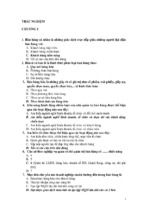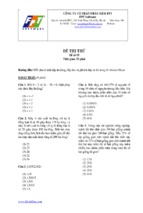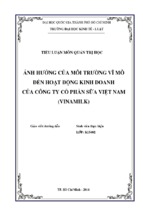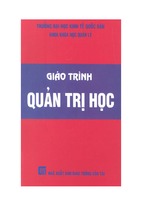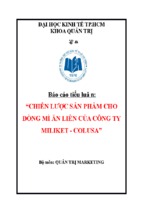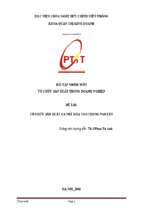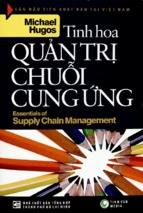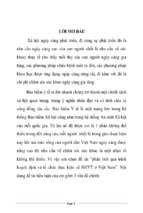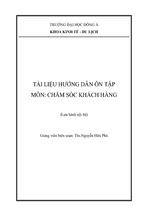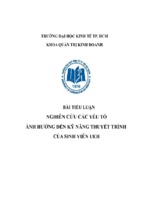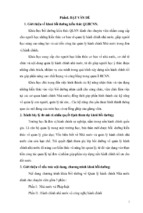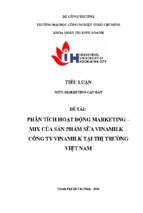HUMAN DIET
35
6
HUMAN DIET
READING COMPREHENSION
Because the human diet is typically diverse, human beings are classified
as omnivores rather than as herbivores (plant eaters) or carnivores (meat
eaters). Certain groups of people do derive most of their food from
animal sources while other people practice vegetarianism. By far the
5 majority of humankind, however, eats a wide range of foods of both
animal and vegetable origin. Prehistoric humans were hunter-gatherers
who fed on animals, insects, berries, roots, and leaves. The range of
dietary choices was extended when humans learned how to use fire for
cooking and when they developed weapons for hunting and trapping
10 larger game; most importantly, they eventually learned how to rear
animals for their own use and how to cultivate crops. Today some
isolated groups are still hunter-gatherers, but most human diets derive
from agriculture and animal husbandry.
Asian-style noodles
Sưu tầm bởi: www.daihoc.com.vn
36
ENGLISH FOR NUTRITION AND FOOD SCIENCES
Italian-style pasta
15 Social factors and cultural practices in most countries have a great
influence on what people eat, on how they prepare food, on their feeding
practices, and on the foods they prefer. Throughout history, different
societies have exhibited great variations in diet. But during the 20th
century, greatly increased world trade and improved communications
20 have resulted in major changes in the variety of foods eaten in many
countries. Asian cuisines have become popular in Europe and North
America, and Western "fast foods" are increasingly available in
developing countries. In general, the staple food in most countries has
not changed.
25 Throughout history, as long as the food supply was sufficient the
traditional diets of most cultures have provided all the essential nutrients.
These are divided into macronutrients (carbohydrates, fats, proteins) and
micronutrients (vitamins and minerals). In general, humans obtain most
of their food energy from carbohydrates (perhaps 65% worldwide);
30 lesser amounts come from fat (about 20%) and protein (about 15%),
mainly from meat and fish.
The major cause of undernutrition and nutritional-deficiency diseases has
seldom been traditional food habits. The usual cause has been a lack of
adequate food due to poverty or consumption of too limited a variety of
35 food. Infectious diseases and lack of care contribute importantly to
malnutrition in children. Protein-energy malnutrition is generally due to
consumption of too little food, and micronutrient deficiencies such as
anemia, iodine deficiency disorders, and pellagra are due to diets
inadequate in specific minerals and vitamins.
40 Advances in agriculture and food-processing techniques have afforded
the potential of increased food supply and a nutritionally enriched diet,
but modernization and Westernization of food habits have also had
deleterious effects. For example, at the turn of the 20th century new rice
milling techniques caused an outbreak of beriberi (a thiamine-deficiency
45 disease) in Asia, resulting in millions of deaths. The substitution of
bottle-feeding for breast-feeding among poor families in developing
countries has been responsible for a great deal of malnutrition and
diarrhea, as well as infant deaths.
Sưu tầm bởi: www.daihoc.com.vn
HUMAN DIET
37
Increasingly, changes in diets in the developing countries due to
50 Westernization and greater affluence has led to an increase in chronic
diseases such as heart disease, diabetes, obesity, hypertension, and
certain cancers. These diseases are already major causes of mortality in
the industrialized countries. Much of this is related to high intakes of
foods of animal origin and a greater percentage of food energy coming
from fats, oils, and sugar and less coming from complex carbohydrates.
Questions: Answer the questions about the reading.
1) Why are human beings classified as omnivores?
2) When was the range of dietary choices extended?
3) What has the major cause of undernutrition and nutritionaldeficiency diseases been?
4) What is the harmful effect of the substitution of bottle-feeding for
breast-feeding among poor families in developing countries?
5) What have changes in diets in the developing countries resulted in?
True-False: Write T if the sentence is true and F if it is false.
1) _____ The major cause of nutritional-deficiency diseases has been
traditional food habits.
2) _____ Most groups of people do derive most of their food from
animal sources.
3) _____ Today no groups are still hunter-gatherers.
4) _____ Social factors and cultural practices in most countries have
a great influence on their feeding practices.
5) _____ Modernization and Westernization of food habits have also
had harmful effects.
VOCABULARY
Fill in these statements with the words in the box.
reared
hypertension
malnutrition
mortality
bottle-feeding
feed
deficiency
vegetarian
staple diet
breast-feeding
1) If you …………… your dog on cakes and biscuits, it's not
surprising he's so fat.
2) A clean water supply played a large part in reducing the
…………… rate.
3) A well-balanced …………… diet can be a lot healthier for you than
the average meat-eater's diet because it contains less fat and more
fiber.
4) The scientists tracked one lot of infected meat back to the farms
where the animals had been …………….
5) Infectious diseases and lack of care contribute importantly to
…………… in children.
Sưu tầm bởi: www.daihoc.com.vn
38
ENGLISH FOR NUTRITION AND FOOD SCIENCES
6) …………… is extremely beneficial to the health of newborn
babies.
7) Pregnant women often suffer from iron …………….
8) We are conducting extensive research into treatments for …………
and heart disease.
9) Bamboo is the panda's …………….
10) She started …………… her baby when she went back to work.
WORD STUDY
A. WORD FORMS: ADJECTIVES
Some common adjective endings are -al, -able, -ful, -less, -t, and -ous.
Look at the words in the list below. Notice the endings on the adjectives.
See how the adjectives are related to the other words.
1)
2)
3)
4)
5)
6)
7)
8)
9)
10)
adjective
experimental
natural
preventable
suitable
believable
successful
violent
different
religious
useful, useless
verb
experiment
—
prevent
suit
believe
succeed
—
differ
—
use
noun
experiment
nature
prevention
—
belief
success
violence
difference
religion
use
Exercise: Choose the best word to complete each sentence. Use a word from
line 1 in sentence 1, and so on.
1) Scientists have planted jojoba and euphorbia crops on ……………
farms in several countries.
2) The ancient Egyptians used plants as ……………………medicine
to treat diseases.
3) Many common diseases of the 19th century are ……………………
now. People no longer get sick from these diseases.
4) There are many wild plants in the woods, but not all of them are
……………………for humans to eat.
5) I don’t ……………………your story about meeting people from
Mars. I don’t think it’s true.
6) The first experiment with the new crop did not ………………… .
The plants died, and the scientists had to begin again.
7) Some people think that television is too …………………… . There
are too many programs that show people fighting and killing each
other.
8) It can be very cold in parts of the United States during the winter,
but it is almost never cold in Australia. The …………………… in
Sưu tầm bởi: www.daihoc.com.vn
HUMAN DIET
39
weather is very great in these two areas of the world.
9) Helen goes to church every day and often reads the Bible. She is
very …………………….
10) The jojoba is a very …………………… plant. It can be used to
soothe burns, to make hair shiny, and to make a drink similar to
coffee.
B. WORD FORMS: ADJECTIVES
Adjectives have only one form. They can never be plural.
Look at these examples:
We have a two-week vacation from school in March.
It is a four-hour flight from Chicago to Los Angeles.
Exercise: Change the words in bold print to hyphenated adjectives and rewrite
the sentences. The first one is done for you.
1) A flight from Los Angeles to London is ten hours.
It is a ten-hour flight from Los Angeles to London.
2) High school students in California have a summer vacation for
three months.
………………………………………………………………………
3) It is a long drive from Toronto to Winnipeg. It takes four days.
………………………………………………………………………
4) It is a short trip from New York to Boston. It is only 200
kilometers.
………………………………………………………………………
C. WORD FORMS
Look at the list of verbs, nouns, and adjectives below. Notice how they
are related to each other.
1)
2)
3)
4)
5)
6)
7)
8)
9)
10)
Verb
—
—
persuade
protect
continue
—
enjoy
suggest
solve
organize
Noun
scene, scenery
science, scientist
persuasion
protection
continuation
history, historian
enjoyment
suggestion
solution
organization
Sưu tầm bởi: www.daihoc.com.vn
Adjective
scenic
scientific
persuasive
protective
continuous
historical
enjoyable
suggestive
—
organized
40
ENGLISH FOR NUTRITION AND FOOD SCIENCES
Exercise: Choose the correct word for each sentence. Use a word from line 1 in
sentence 1, and so on.
1) Kei brought a book of photographs of Japan to class last week.
Japan has very beautiful ………………………. We saw pictures of
mountains, lakes, and lovely cherry trees.
2) Chemistry and biology are two kinds of ………………………… .
3) Bill could persuade you to do almost anything. He is a very
………………………… person. He talked me into going camping
in Yellowstone National Park.
4) Some of the huge redwood trees in California are under the
………………………… of the National Park Service. The service
keeps the trees safe and healthy.
5) Workers can become very tired of the ……………………… noise
in a factory. The noise never stops.
6) Most countries have a ……………………… museum that explains
the history of the country in pictures, films, and art.
7) People of all ages like to go to national parks. A visit to a national
park is …………………… for the whole family.
8) I would like to make a ……………………… for your trip. Take a
train ride across Canada. I did it last year. The scenery is beautiful.
9) Many countries are trying to ……………………… the problem of
the growth of the deserts.
10) The United Nations is an international ………………………….
STRUCTURE STUDY
REDUCTION OF RELATIVE CLAUSES
Relative clauses are often reduced or contracted as follows:
The man who is talking to John is from Korea.
The man talking to John is from Korea.
English has an alphabet that consists of 26 letters.
English has an alphabet consisting of 26 letters.
Anyone who wants to come with us is welcome.
Anyone wanting to come with us is welcome.
The ideas which are presented in that book are interesting.
The ideas presented in that book are interesting.
Half of the people who had been invited to the party didn t turn up.
Half of the people invited to the party didn t turn up.
Sưu tầm bởi: www.daihoc.com.vn
HUMAN DIET
41
Exercise: Reduce (contract) the underline part of the following sentences:
1) An agreement has been signed to protect the forests which are being
cut down all over the world.
2) Be sure to follow the instructions that are given at the top of the
page.
3) Companies that already use computers have found that the number
of staff that is needed for stock-control can be substantially reduced.
4) Did you get the message that concerned the special meeting?
5) Do you know the woman who is coming toward us?
6) Her books, which are read by people all over the world, are still
immensely popular.
7) I come from a city that is located in the southern part of the country.
8) I haven’t yet had an opportunity to think over the proposals that
were made at the last meeting.
9) The children who attend that school receive a good education.
10) The experiment which was conducted at the University of Chicago
was successful.
11) The fence which surrounds our house is made of wood.
12) The firm’s latest product, which was launched only six months ago,
has already captured a significant share of the market.
13) The head office has now moved to new premises which overlook
the Thames.
14) The Indians who lived in Peru before the discovery of the New
World by Europeans belonged to the Incan culture.
15) The new hostel, which accommodates 200 students, will be opened
next month.
16) The people who are being asked to take early retirement are all over
the age of 60.
17) The people who are waiting for the bus in the rain are getting wet.
18) The psychologists who study the nature of sleep have made
important discoveries.
19) The scientists who are searching the causes of cancer are making
progress.
20) Their letter, which explained why they had not paid promptly,
arrived a few days later.
21) They live in a house that was built in 1890.
22) They sent us an invoice that gave details of all the goods that had
been ordered.
23) We can deliver within three days any articles that are ordered from
stock.
24) We have an apartment which overlooks the park.
25) We received your Giro slip today, which informed us that you had
paid £126.00 into your account.
Sưu tầm bởi: www.daihoc.com.vn
42
ENGLISH FOR NUTRITION AND FOOD SCIENCES
7
FOOD POISONING
READING COMPREHENSION
Foodborne illness or food poisoning is caused by consuming food
contaminated with pathogenic bacteria, toxins, viruses, prions or
parasites. Such contamination usually arises from improper handling,
preparation or storage of food. Foodborne illness can also be caused by
5 adding pesticides or medicines to food, or by accidentally consuming
naturally poisonous substances like poisonous mushrooms or reef fish.
Contact between food and pests, especially flies, rodents and
cockroaches, is a further cause of contamination of food.
Although most mushrooms are edible, several
species can cause serious poisoning
Some common diseases are occasionally foodborne mainly through the
10 water vector, even though they are usually transmitted by other routes.
These include infections caused by Shigella, Hepatitis A, and the
parasites Giardia lamblia and Cryptosporidium parvum.
WORLD HEALTH ORGANIZATION DEFINITION
Foodborne illnesses are defined by the World Health Organization as diseases,
usually either infectious or toxic in nature, caused by agents that enter the
body through the ingestion of food. Every person is at risk of foodborne illness.
Preventing Bacterial Food Poisoning
Sưu tầm bởi: www.daihoc.com.vn
FOOD POISONING
43
The prevention is mainly the role of the state, through the definition of
15 strict rules of hygiene and a public service of veterinary survey of the
food chain, from farming to the transformation industry and the delivery
(shops and restaurants). This regulation includes:
• traceability: in a final product, it must be possible to know the
origin of the ingredients (originating farm, identification of the
20
harvesting or of the animal) and where and when it was
processed; the origin of the illness can thus be tracked and
solved (and possibly penalized), and the final products can be
removed from the sale if a problem is detected;
• respect of hygiene procedures like HACCP and the "cold chain";
25
• power of control and of law enforcement of the veterinarians.
At home, the prevention mainly consists of:
• the respect of the food storage and food preservation methods
(especially refrigeration), and checking the expiration date;
• washing the hands before preparing the meal and before eating;
30
• washing the fresh vegetables with clear water, especially when
not cooked (e.g. fruits, salads);
• washing the dishes after use;
• keeping the kitchen clean.
Spray washing of harvested tomatoes prior to processing.
Bacteria need warmth, moisture, food and time to grow. The presence,
35 or absence, of oxygen, salt, sugar and acidity are also important factors
for growth. In the right conditions, one bacterium can multiply using
binary fission to become four million in eight hours. Since bacteria can
be neither smelled nor seen, the best way to ensure that food is safe is to
follow principles of good food hygiene. This includes not allowing raw
40 or partially cooked food to touch dishes, utensils, hands or work
surfaces previously used to handle even properly cooked or ready to eat
food.
High salt, high sugar or high acid levels keep bacteria from growing,
Sưu tầm bởi: www.daihoc.com.vn
44
ENGLISH FOR NUTRITION AND FOOD SCIENCES
which is why salted meats, jam, and pickled vegetables are traditional
45 preserved foods.
The most frequent causes of bacterial foodborne illness are crosscontamination and inadequate temperature control. Therefore control of
these two matters is especially important.
Thoroughly cooking food until it is piping hot, i.e. above 70°C will
50 quickly kill virtually all bacteria, parasites or viruses, except for
Clostridium botulinum and Clostridium perfringens, which produces a
heat-resistant spore that survives temperatures up to 100°C. Once
cooked, hot foods should be kept hot – above 63°C stops microbial
growth.
55 Cold foods should be kept cold, below 5°C (41°F). However, Listeria
monocytogenes and Yersinia enterocolitica can both grow at refrigerator
temperatures.
Questions: Answer the questions about the reading.
1)
2)
3)
4)
5)
What is food poisoning according to the WHO?
How are foodborne diseases are transmitted?
What regulations should be observed to avoid food poisoning?
What must be done at home to avoid poisoning?
What are the most frequent causes of bacterial foodborne illness?
True-False: Write T if the sentence is true and F if it is false.
1) _____ Contact between food and pests is also a cause of
contamination of food.
2) _____ All diseases are occasionally foodborne mainly through
the water vector.
3) _____ The prevention against bacterial food poisoning is mainly
the role of the state.
4) _____ Bacteria need warmth, moisture, food and time to grow.
5) _____ Cooking food until above 70°C will kill all bacteria,
parasites or viruses.
Sưu tầm bởi: www.daihoc.com.vn
FOOD POISONING
45
VOCABULARY
Fill in these statements with the words in the box.
veterinary
spore
vectors
ingredient
food chain
expiration
hygiene
poisonous
viruses
contaminated
1) The best way to ensure that food is safe is to follow principles of
good food …………….
2) The drinking water has become …………… with lead.
3) Can you tell me the difference between …………… mushrooms
and edible varieties?
4) Following the outbreak of the disease, several sheep and lambs
were destroyed on …………… advice.
5) Sheep products are being fed to cows, thereby passing into the
human …………….
6) Coconut is a basic …………… for many curries.
7) The …………… date on this yogurt was November 20.
8) Mosquitoes are the …………… of malaria.
9) This group of bacteria have the ability to change into a dormant
form called a …………… if the cell starts to run out of food.
10) In humans, …………… cause such illnesses as the common cold,
flu and measles.
WORD STUDY
A. -IZE
You can change some words into verbs by adding the suffix -ize. The
suffix -ize means “to make into (something)” or “to cause to be
(something).”
Here is an example:
Radio helped to popularize country music.
popular + -ize = to make something (country music) popular
Spelling Note: When a word ends in y, drop they before adding
-ize.
Exercise: Add the suffix -ize to each word. Then choose the best word for each
sentence. Be sure to use the correct tense.
memory ……………………
winter ……………………
colony ……………………
special
……………………
modern ……………………
industrial ……………………
Sưu tầm bởi: www.daihoc.com.vn
46
ENGLISH FOR NUTRITION AND FOOD SCIENCES
1) Spain and Portugal started many new cities in the New World,
especially south of Mexico. These two countries …………………
most of Central and South America.
2) The Greens bought a beautiful old house in the country. They
………………………… the kitchen by adding a dishwasher, a
microwave, and a new refrigerator. The rest of the house is not
modern. It has simple furniture and old wood floors, but it’s very
nice.
3) Victor is studying engineering at the university. After two years of
general studies, he wants to ………………………… in biomedical
engineering.
4) Sometimes there are no rules for irregular verbs in English. If you
want to remember them, you have to …………………………
them and use them often.
5) Every fall I take my car to the auto mechanic. He changes the oil
and adds some chemicals to help it run well during the winter. He
thinks all people should ………………………… their cars to
prevent problems during the very cold months.
6) Developing countries want to …………………………as fast as
possible. They want to change from a society of farm workers to a
society of modern factory workers. Having a strong industry will
help these countries grow.
B. -IVE
Adjectives that end with the suffix -ive mean “able to do something.”
Here is an example:
David is very persuasive. He can persuade people to do almost
anything.
Exercise: Look at the list of adjectives with the suffix -ive. Notice how they are
related to other words. Then choose the best adjective for each
sentence.
adjective
(un)productive
(un)imaginative
(in)active
(non)destructive
(un)protective
other forms
product (noun)
imagine (verb)
act (verb)
destruction (noun)
protect (verb)
1)
Ahmed is very ………………………… in the International
Student Organization. He goes to meetings every week and helps
the new members get to know each other.
2) Desert soil is ………………………… without water. Even desert
plants need water. Without it, the soil becomes dry and cannot
produce healthy plants.
3) The storms were very …………………………. The winds
knocked over trees and damaged houses.
4) Writers and artists are very …………………………people. They
Sưu tầm bởi: www.daihoc.com.vn
FOOD POISONING
47
need to have wild imaginations to create stories and paintings.
5) Ms. Miller is very …………………………of her children. She
worries that something bad will happen to one of them, so she tries
to protect them and keep them safe.
C. WORD FORMS
Exercise: Look at the words in the list. Notice how they are related to each
other. Then choose the best word for each sentence. Use a word
from line 1 in sentence 1, and so on.
1)
2)
3)
4)
5)
verb
prepare
value
encourage
—
imagine
6) produce
7) discover
8) depend
9) educate
10) colonize
noun
preparation
value
encouragement
ice
imagination
product / production
discovery
(in)dependence
education
colony
adjective
—
valuable
encouraging
icy
(un)imaginative /
(un)imaginable
(un)productive
—
(in)dependent /
(un)dependable
educational
colonial
1) A big holiday dinner requires special ………………… . We clean
the house and spend hours and hours in the kitchen preparing
everything we need. It is a lot of work and a lot of fun.
2) Gold is more …………… than silver. It is always more expensive.
3) George succeeded at the university because his parents gave him so
much ………………… Every day they told him to keep working
hard. They told him they were proud of him. They knew he could
do it, and he did.
4) Yesterday afternoon it rained, and at night the temperature dropped
below zero. In the morning the streets were covered with
…………………………. Driving was very dangerous.
5) What do you think life will be like in 200 years? Use your
…………………………and describe what you think.
6) Japan has greatly increased its …………………………of cars.
More cars are made in Japan now than ever before.
7) Marie Curie made an important scientific ……………………… .
She discovered radium.
8) David is very …………………………. If he says he will do
something, you always know he will do it.
9) Films used in the classroom are usually ……………………. They
provide information we can learn. Films at movie theaters are
usually for enjoyment only.
10) People in Quebec speak French because Quebec was once a French
……………………….
Sưu tầm bởi: www.daihoc.com.vn
48
ENGLISH FOR NUTRITION AND FOOD SCIENCES
STRUCTURE STUDY
ADVERBIAL CLAUSES
Adverbial clauses, like adverbs, tell us something further about the verb
and answer the questions When? Where? How? Why? etc.
Here are some of the most common conjunctions used to introduce
adverbial clauses:
Time
Place
Manner
Comparison
Reason
Purpose
Result
Condition
Contrast
Note:
when, after, before, as, as soon as, by the time (that),
once, since/ever since, until/till, whenever, while
where, wherever, anywhere, everywhere
as, as if, as though
than, as ... as
because, as, since
so that, in order that, in case
so ... that, such a ... that
if, unless, provided/providing (that), so/as long as
although/though/even though, while, whereas
We generally use the present simple to refer to the future in
adverbial clauses of time and condition:
When/If I come to London, I ll come and see you.
and we use the present perfect in place of the future perfect:
When I ve finished my dinner, I ll come and help you.
Exercise: Complete the following with an appropriate conjunction. In some
sentences, more than one conjunction is possible.
1)
2)
3)
4)
5)
6)
7)
8)
9)
10)
11)
I’m sorry I wasn’t here earlier but I came ……………… I could.
I’m staying in all weekend ……………… I can get my work done.
He spoke to me ……………… it was all my fault.
He didn’t react ……………… I’d hoped; he was actually rather
angry.
Things are never ……………… bad ……………… you think they
are.
He’d like to be an actor ……………… his father would like him to
be a lawyer.
She’s ……………… interested in her work ……………… she
never seems to do anything else.
I’ll meet you ……………… you like; I don’t mind where it is.
I won’t believe you ………………………… I’ve seen it for
myself.
She seems happy ………………………… she can’t find a job.
………………………… I didn’t feel very well, we decided to
leave early.
Sưu tầm bởi: www.daihoc.com.vn
FOOD POISONING
49
12) The money was hidden ……………… no-one could find it.
13) ……………… he’s not interested in classical music, he decided
not to go to the concert.
14) I’ll come with you ……………… we don’t stay late. I need to be
up early tomorrow.
15) ……………… I like him, I sometimes find him very irritating.
16) I’ll give you my phone number ……………… you need to get in
touch with me.
17) You can’t travel abroad ……………… you have a passport.
18) ……………… no one has any further questions, the meeting will
be adjourned.
19) ……………… bacteria can be neither smelled nor seen, the best
way to ensure that food is safe is to follow principles of good food
hygiene.
20) Some common diseases are occasionally foodborne mainly through
the water vector, ……………… they are usually transmitted by
other routes.
21) At simplest, processing may involve only picking, sorting, and
washing fruits and vegetables ……………… they are sent to
market.
22) ……………… people have known about spoilage and some
preservation methods to prevent it for centuries, it was only in 1857
that French chemist Louis Pasteur demonstrated the role of
microorganisms in the process.
23) Curing and smoking preserve food by binding or removing water
…………… it is not available for the growth of microorganisms.
24) Refrigeration is advantageous ……………… it does not cause
chemical or physical changes to food.
25) …………… irradiation involves minimal heating, it has very little
effect on the taste, texture, and nutritive value of food.
26) Genetic engineering has been practiced for thousands of years,
…………… humans began selectively breeding plants and animals
to create more nutritious, better tasting foods.
27) A person can survive only eight to ten days without water,
…………… it takes weeks or even months to die from a lack of
food.
28) Water needs are increased …………… a person suffers from
diarrhea or vomiting or undergoes heavy physical exercise.
29) …………… fibers provide no energy or building materials, they
play a vital role in our health.
30) Warm-blooded animals require more food for energy production
…………… do cold-blooded animals.
Sưu tầm bởi: www.daihoc.com.vn
50
ENGLISH FOR NUTRITION AND FOOD SCIENCES
8
ORGANIC FOOD
READING COMPREHENSION
Organic food has both a popular meaning, and in some countries, a legal
definition. In everyday conversation, it usually refers to all “naturally
produced” foods, or the product of organic farming. As a legal term, it
means certified organic. The distinction is important, as the two
5 definitions can represent quite different products.
Types of organic food
Organic foods, like food in general, can be grouped into two categories,
fresh and processed, based on production methods, availability and
consumer perception.
10 Fresh food is seasonal and highly perishable. Fresh produce – vegetables
and fruits – is the most available type of organic food, and closely
associated with organic farming. It is often purchased directly from the
growers, at farmers' markets, from on-farm stands, through specialty
food stores, and through community-supported agriculture projects.
15 Unprocessed animal products – organic meat, eggs, dairy – are less
common. Prices are significantly higher than for conventional food, and
availability is lower. They are still premium priced items.
For fresh food, “organic” usually means:
• produced without synthetic chemicals (e.g. fertilizers, pesticides,
antibiotics, hormones)
20
• free of genetically modified organisms
• (often, but not necessarily) locally grown
Processed food accounts for most of the items in a supermarket. Little of
Sưu tầm bởi: www.daihoc.com.vn
ORGANIC FOOD
51
it is organic, and organic prices are often high. In spite of this, organic
25 processed products are now primarily purchased from supermarkets.
The majority of processed organics comes from large food
conglomerates, as producing and marketing products like frozen entrees
and other convenience foods is beyond the scope of the original small
organic producers.
30 For processed organic food, the general definition is:
• contains only (or at least a certain specified percentage of)
organic ingredients
• contains no artificial food additives
• processed without artificial methods, materials and conditions
(e.g. no chemical ripening, no food irradiation)
35
Organic Farming
Identifying organic food
Early organic consumers, looking for essentially chemical-free fresh or
minimally processed food, had to buy direct from growers: Know your
farmer, know your food was a practical reality. Organic food at first
40 comprised mainly fresh vegetables. Individual ideas of what exactly
constituted “organic” could be developed and verified through talking to
farmers and actually observing farm conditions and farming activities.
Small farms can grow vegetables (and raise livestock) using organic
farming practices, with or without certification, and this is more or less
45 something a direct consumer can monitor.
As consumer demand for organic foods increases, high volume sales
through mass outlets, typically supermarkets, is rapidly replacing the
direct farmer connection. For supermarket consumers, food production
is not easily observable. Product labeling, like “certified organic”, is
50 relied on. Government regulations and third-party inspectors are looked
to for assurance.
With widespread distribution of organic food, the processed food
Sưu tầm bởi: www.daihoc.com.vn
52
ENGLISH FOR NUTRITION AND FOOD SCIENCES
category has also become dominant, confusing the issue further.
Processed foods are more difficult to understand non-technically.
55 Commercial preparation methods, food additives, packaging, and the
like are outside the direct experience of most people (including organic
farmers). Traditional and minimally processed products, like flour and
rice; baked goods; and canned, frozen, and pickled fruits and vegetables,
are easier for consumers to understand by comparison with home
60 preparation methods, although home and mass-production techniques
are quite different. For convenience foods, like frozen prepared dishes,
cooked breakfast cereals, and margarine, ingredients and methods are
quite a mystery. A “certified organic” label is usually the only way for
consumers to trust that a processed product is “organic”.
Questions: Answer the questions about the reading.
1)
2)
3)
4)
5)
What are the two meanings of the term “organic food”?
For fresh food, what does “organic” usually mean?
For processed organic food, what does “organic” usually mean?
How was organic food identified in the past?
How is organic food identified nowadays?
True-False: Write T if the sentence is true and F if it is false.
1) _____ Prices for organic food are significantly higher than for
conventional food.
2) _____ Most of the items in a supermarket are unprocessed.
3) _____ Processed organic food must not contain any food
additives.
4) _____ Small farms that grow vegetables and raise livestock using
organic farming practices need certification.
5) _____ Consumers can identify an organic processed product only
thanks to a “certified organic” label.
VOCABULARY
Fill in these statements with the words in the box.
perishable
livestock
convenience farming
cereal
categories
entrée
additives
ripen
conventional
1) Organic foods can be grouped into two, …………… fresh and
processed.
2) The classification of …………… by 'E' number is made under an
EC directive.
3) The supermarket has its …………… foods delivered by air rather
than truck to ensure freshness.
4) …………… food is food that is almost ready to eat when it is
bought and can be prepared for eating quickly and easily.
Sưu tầm bởi: www.daihoc.com.vn
ORGANIC FOOD
53
5) Organic food is usually much more expensive than ……………
food.
6) Farmers are involved in a constant battle to control vermin which
ruin their crops and damage their …………….
7) The …………… is the main dish of the meal or a dish served
before the main course.
8) Olives turn from green to black as they …………….
9) Cornflakes are a popular breakfast …………… in Britain.
10) Sheep …………… is a major business in Australia and New
Zealand.
WORD STUDY
A. -SHIP
Many nouns end in -ship. The suffix -ship means “the condition of’” or
“the art of.”
Here are some examples:
One United Nations conference was about the uses and ownership
of oceans.
Alex and I have had a wonderful friendship for many years.
Exercise: Add the suffix -ship to each word. Then choose the best word for
each sentence. Make the word plural if necessary.
member
hard
sportsman
…………………
…………………
…………………
friend
…………………
relation …………………
1) People who play sports should follow the rules of the game and be
friendly to the other team. This is good ………………………….
2) Life was very difficult for the first explorers of Antarctica. The
weather was terribly cold, they didn’t always have enough to eat,
and some of them died. These early explorers suffered many
………………………….
3) The …………………… of the International Student Organization
increases every semester. This semester there are 105 members —
that’s 20 more members than before.
4) Marie and Anne became friends when they were in school together.
Now they are both grandmothers, and they are still friends. Their
………………………… has lasted for more than fifty years!
5) What is the ………………………… between goats and deserts?
How do goats cause deserts to become larger?
Sưu tầm bởi: www.daihoc.com.vn
54
ENGLISH FOR NUTRITION AND FOOD SCIENCES
B. ENSometimes we can add the prefix en- to a word to make a verb. The
meaning of the new verb is related to the meaning of the original word.
Look at these examples:
Police sometimes use force to enforce laws.
I want this picture made larger. I will take it to the photo store to
have it enlarged.
Exercise: Add the prefix en- to each word. Then choose the best verb for each
sentence. Be sure to use the correct endings and tenses.
joy
able
rich
……………………
……………………
……………………
large
danger
……………………
……………………
1) Some soil is very poor and is not good for growing crops. Farmers
need to ………………… the soil in order for plants to grow.
2) United Nations organizations ………………………… people in
developing countries to improve their education programs and
industry.
3) David really ………………………… his trip to Yellowstone
National Park last summer. He said he had a wonderful time.
4) The Smiths think their house is too small for their family. They
want to ……………………… it by adding two more bedrooms.
5) Krill is important to the chain of life in the Antarctic Ocean. If
humans catch too much krill, it might ………………………… the
lives of penguins and other animals that need krill for food.
C. -AGE
Many nouns in English end with the suffix -age.
Look at the example:
A passage connects those two buildings. In winter people can walk
through the hall from one building to the other without going
outside.
Exercise: Add the suffix -age to each word. Then choose the best noun for
each sentence.
Spelling notes:
If a word ends in y, change they to i before adding -age.
If a word ends in e, drop the e before adding -age.
marry
short
store
……………………
……………………
……………………
out
post
pack
……………………
……………………
……………………
1) Louis bought presents to send to his parents. He packed them
carefully in a box. Then he took the ………………………… to the
Sưu tầm bởi: www.daihoc.com.vn
- Xem thêm -

